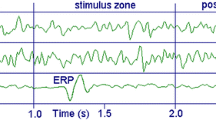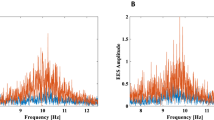Abstract
The event-related potentials (ERPs) are an essential response of the human brain to environmental changes that correlate with behavior. They are thus widely used as indicators of brain activity in fundamental research and response sources in brain communication devices. The problem of their robust identification from single-trial EEG recordings or limited data sets is timely and challenging. The current study addresses this issue by evaluating the ERP-associated variations of EEG signals using the measures of complexity based on the recurrence quantification analysis (RQA). Specifically, we demonstrate that the recurrence time entropy (RTE) is a good indicator of ERP-associated changes in the course of successive discrimination of ambiguous visual stimuli. Using the distribution of recurrence times, we conclude why exactly this measure is sensitive to ERP-associated variations of EEG signal.





Similar content being viewed by others
Data availability statement
This manuscript has associated data in a data repository: https://doi.org/10.6084/m9.figshare.12155343.v2.
References
M.D. Rugg, T. Curran, Event-related potentials and recognition memory. Trends Cogn. Sci. 11(6), 251–257 (2007)
S.J. Luck, E.S. Kappenman, The Oxford Handbook of Event-related Potential Components (Oxford University Press, Oxford, 2011)
C.S. Herrmann, R.T. Knight, Mechanisms of human attention: event-related potentials and oscillations. Neurosci. Biobehav. Rev. 25(6), 465–476 (2001)
B. Kotchoubey, Event-related potentials, cognition, and behavior: a biological approach. Neurosci. Biobehav. Rev. 30(1), 42–65 (2006)
S.L. Shishkin, I.P. Ganin, A.Y. Kaplan, Event-related potentials in a moving matrix modification of the p300 brain-computer interface paradigm. Neurosci. Lett. 496(2), 95–99 (2011)
I.P. Ganin, S.L. Shishkin, A.Y. Kaplan, A p300-based brain-computer interface with stimuli on moving objects: four-session single-trial and triple-trial tests with a game-like task design. PloS One 8(10), 77755 (2013)
A. Kaplan, D. Zhigulskaya, D. Kirjanov, Studying the ability to control human phantom fingers in p300 brain-computer interface. Bull. Russ. State Med. Univ. 2, 24–28 (2016)
N. Marwan, M.C. Romano, M. Thiel, J. Kurths, Recurrence plots for the analysis of complex systems. Phys. Rep. 438(5–6), 237–329 (2007)
C.L. Webber, N. Marwan, Recurrence quantification analysis. Theory Best Pract. (2015)
R. Acharya, O. Faust, N. Kannathal, T. Chua, S. Laxminarayan, Non-linear analysis of eeg signals at various sleep stages. Comput. Methods Prog. Biomed. 80(1), 37–45 (2005)
S. Carrubba, P.Y. Kim, D.E. McCarty, A.L. Chesson Jr., C. Frilot, A.A. Marino, Continuous eeg-based dynamic markers for sleep depth and phasic events. J. Neurosci. Methods 208(1), 1–9 (2012)
U.R. Acharya, V.K. Sudarshan, H. Adeli, J. Santhosh, J.E. Koh, A. Adeli, Computer-aided diagnosis of depression using eeg signals. Eur. Neurol. 73(5–6), 329–336 (2015)
U.R. Acharya, S. Bhat, O. Faust, H. Adeli, E.C.-P. Chua, W.J.E. Lim, J.E.W. Koh, Nonlinear dynamics measures for automated eeg-based sleep stage detection. Eur. Neurol. 74(5–6), 268–287 (2015)
V.A. Maksimenko, N.S. Frolov, A.E. Hramov, A.E. Runnova, V.V. Grubov, J. Kurths, A.N. Pisarchik, Neural interactions in a spatially-distributed cortical network during perceptual decision-making. Front. Behav. Neurosci. 13, 220 (2019)
E. Pitsik, N. Frolov, K. Hauke Kraemer, V. Grubov, V. Maksimenko, J. Kurths, A. Hramov, Motor execution reduces eeg signals complexity: recurrence quantification analysis study. Chaos Interdiscip. J. Nonlinear Sci. 30(2), 023111 (2020)
N. Frolov, V. Maksimenko, A. Hramov, Revealing a multiplex brain network through the analysis of recurrences. Chaos Interdiscip. J. Nonlinear Sci. 30(12), 121108 (2020)
E.N. Pitsik, Recurrence quantification analysis provides the link between age-related decline in motor brain response and complexity of the baseline eeg. Izvestiya Vysshikh Uchebnykh Zavedeniy-prikladnaya Nelineynaya Dinamika 29(3), 386–397 (2021)
N. Marwan, A. Meinke, Extended recurrence plot analysis and its application to erp data. Int. J. Bifurcat. Chaos 14(02), 761–771 (2004)
S. Schinkel, N. Marwan, J. Kurths, Order patterns recurrence plots in the analysis of erp data. Cogn. Neurodyn. 1(4), 317–325 (2007)
N. Marwan, A. Groth, J. Kurths, Quantification of order patterns recurrence plots of event related potentials. Chaos Complex. Lett. 2, 301–314 (2007)
E. Pitsik, N. Frolov, Recurrence quantification analysis detects p300 on single-trial eeg. In: 2021 5th Scientific School Dynamics of Complex Networks and Their Applications (DCNA), pp. 155–158 (2021). IEEE
E. Pitsik, Recurrence quantification analysis of p300 event-related potential on single-trial eeg. Bull. Russ. Acad. Scie. Phys. 86(2), 211–215 (2022)
K.H. Kraemer, R.V. Donner, J. Heitzig, N. Marwan, Recurrence threshold selection for obtaining robust recurrence characteristics in different embedding dimensions. Chaos Interdiscip. J. Nonlinear Sci. 28(8), 085720 (2018)
C.L. Wiggs, A. Martin, Properties and mechanisms of perceptual priming. Curr. Opin. Neurobiol. 8(2), 227–233 (1998)
M. Kutas, K.D. Federmeier, Electrophysiology reveals semantic memory use in language comprehension. Trend Cogn. Sci. 4(12), 463–470 (2000)
J.F. Donges, J. Heitzig, B. Beronov, M. Wiedermann, J. Runge, Q.Y. Feng, L. Tupikina, V. Stolbova, R.V. Donner, N. Marwan et al., Unified functional network and nonlinear time series analysis for complex systems science: the pyunicorn package. Chaos Interdiscip. J. Nonlinear Sci. 25(11), 113101 (2015)
E. Maris, R. Oostenveld, Nonparametric statistical testing of eeg-and meg-data. J. Neurosci. Methods 164(1), 177–190 (2007)
A. Gramfort, M. Luessi, E. Larson, D.A. Engemann, D. Strohmeier, C. Brodbeck, R. Goj, M. Jas, T. Brooks, L. Parkkonen et al., Meg and eeg data analysis with mne-python. Front. Neurosci. 267 (2013)
J.Z. Bakdash, L.R. Marusich, Repeated measures correlation. Front. Psychol. 8, 456 (2017)
R. Vallat, Pingouin: statistics in python. J. Open Sour. Softw. 3(31), 1026 (2018)
Funding
The study was supported by the Russian Foundation for Basic Research (Grant number 19-32-60042) in the part of electrophysiological experiment. The data analysis was supported by the Program of Scientific School Support (Grant number NSH-589.2022.1.2).
Author information
Authors and Affiliations
Contributions
All authors contributed to the study conception and design. Material preparation, data collection and analysis were performed by NF, EP and VM. The study was supervised and coordinated by AH. The first draft of the manuscript was written by NF and all authors commented on previous versions of the manuscript. All authors read and approved the final manuscript.
Corresponding author
Ethics declarations
Conflict of interest
The authors have no relevant financial or non-financial interests to disclose.
Rights and permissions
Springer Nature or its licensor (e.g. a society or other partner) holds exclusive rights to this article under a publishing agreement with the author(s) or other rightsholder(s); author self-archiving of the accepted manuscript version of this article is solely governed by the terms of such publishing agreement and applicable law.
About this article
Cite this article
Frolov, N., Pitsik, E., Maksimenko, V. et al. Applying recurrence time entropy to identify changes in event-related potentials. Eur. Phys. J. Spec. Top. 232, 161–168 (2023). https://doi.org/10.1140/epjs/s11734-022-00743-y
Received:
Accepted:
Published:
Issue Date:
DOI: https://doi.org/10.1140/epjs/s11734-022-00743-y




